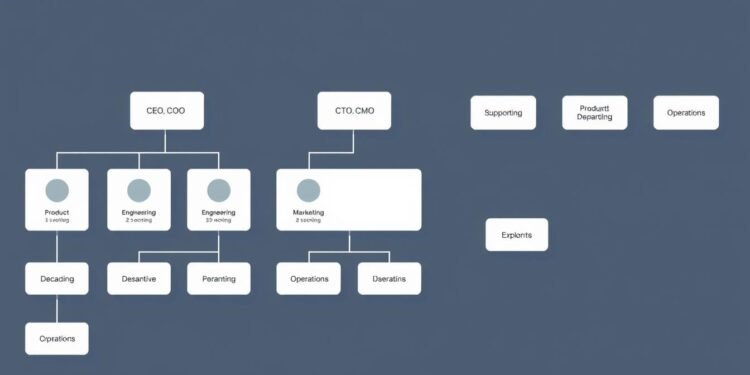How can a growing business maintain clarity when scaling rapidly? Startups often struggle with defining roles, streamlining communication, and keeping teams aligned—especially in fast-paced environments. A well-structured organizational structure helps solve these challenges by visually mapping responsibilities and hierarchies.
Tools like Miro and Notion offer dynamic solutions tailored for early-stage companies. Miro’s customizable templates serve over 80 million users, while Notion’s collapsible sections and app integrations enhance real-time collaboration. These features ensure teams stay connected, whether remote or in-office.
Clear hierarchies don’t just improve operations—they also boost investor confidence. A transparent structure demonstrates professionalism and scalability, key factors for securing funding. For startups, visualizing growth isn’t optional; it’s a strategic necessity.
Key Takeaways
- Visualizing roles prevents confusion during rapid scaling.
- Miro’s templates support 80M+ users with startup-friendly features.
- Notion offers collapsible hierarchies and app integrations.
- Clear structures attract investor trust and funding.
- Remote teams benefit from real-time collaboration tools.
Why Startups Need an Org Chart Template
Ambiguity in responsibilities slows down fast-growing teams. Research shows 22% of startup failures link to poor organizational charts and role confusion. A visual hierarchy solves this by mapping who does what.
Notion tackles miscommunication with color-coded roles. Employees instantly recognize responsibilities, reducing onboarding time. This clarity is critical for remote team members.
Whimsical’s flat structures avoid bureaucratic delays. Unlike traditional hierarchies, they empower employees to make decisions faster. This agility suits startups scaling rapidly.
Matrix charts excel for cross-functional projects. They show collaboration between departments, like product and marketing. Dual reporting lines become transparent.
Miro’s CSV import adapts to frequent changes. Founders update information without redesigning charts manually. This flexibility keeps pace with growth.
Types of Org Charts for Startups
Different growth phases demand distinct approaches to team organization. Startups often experiment with structures to balance agility and clarity. Below are three common models, each suited to specific scaling needs.
Hierarchical Org Charts
Traditional hierarchy works for clear chains of command. Roles branch from executives to managers, then teams. This suits startups transitioning to formal processes.
Resource allocation is centralized in this model. Leaders control budgets and approvals, reducing redundancy. However, decision-making can slow down rapid iterations.
Flat Org Charts
Valve’s success proves flat org charts foster innovation. Employees self-organize without rigid titles. Projects drive collaboration, not top-down mandates.
This model cuts bureaucracy but requires strong culture. Notion blends flat and functional elements for hybrid flexibility. Departments exist, but roles overlap dynamically.
Matrix Org Charts
Matrix systems shine for cross-functional teams. A developer might report to both engineering and product leads. Miro’s templates visualize these dual-reporting lines.
Whimsical’s pod-based charts simplify scaling. Pods act as mini-teams within departments. This balances autonomy with alignment, ideal for rapid growth phases.
Benefits of Using an Org Chart Template
Visual tools transform how teams align during expansion. Miro users report 40% faster onboarding with dynamic charts. New hires grasp team structures instantly, reducing ramp-up time.
Notion’s RACI matrix eliminates task duplication. It defines roles clearly—who’s Responsible, Accountable, Consulted, or Informed. This prevents overlaps in fast-moving projects.
Whimsical’s goal-tracking sliders sync with OKRs. Teams adjust priorities visually, keeping planning agile. Progress updates become transparent across all levels.
Cross-departments benefit from shared visibility. Carted’s startup wiki links charts to project docs. Marketing and engineering see dependencies at a glance.
Miro’s branding options impress investors. Custom colors and logos make organizations look polished. A professional layout signals scalability and vision.
Top Org Chart Templates for Startups
Finding the right visual tool can make or break team alignment in fast-scaling companies. The best chart templates adapt to growth while keeping roles crystal clear. Below are three standout options for dynamic teams.
Miro’s Flat Org Chart Template
Miro’s template handles complex networks effortlessly. Its CSV import supports 100+ employee mappings, ideal for rapid hiring phases. Updates sync in real time, eliminating manual redesigns.
Export as PNG for investor decks or internal wikis. The drag-and-drop editor simplifies adjustments as teams pivot.
Notion’s Roles and Responsibilities Template
Notion blends LinkedIn integrations with “peek mode” for layered department views. Assign names and roles visually, with emoji badges for quick recognition.
Shareable links let remote teams access live updates. The RACI matrix embedded in this template prevents task overlaps.
Whimsical’s Team Hub
Whimsical merges pod structures with OKR tracking. Color-coded sliders show sprint progress alongside org charts. This dual view aligns daily tasks with quarterly goals.
Progress bars update automatically, making it a favorite for agile chart templates.
How to Choose the Right Org Chart Template
Selecting the optimal visual framework requires matching team dynamics with growth trajectories. A 15-template comparison study reveals that organizational structure tools vary widely in flexibility and scalability.
Start with a decision matrix. Teams under 20 work best with flat templates, while larger groups need layered hierarchies. Miro’s widget adapts to real-time changes, unlike static PowerPoint slides.
Evaluate tech stack compatibility. Notion’s API integrations sync with HR tools like BambooHR, automating updates. This reduces manual errors during rapid hiring phases.
Plan for scaling. Templates should accommodate 10 to 100+ employees without redesigns. Miro’s CSV import handles bulk additions, while Whimsical’s pod system isolates department changes.
Prioritize security. Sensitive data like salaries requires role-based access controls. Notion’s permission tiers and audit logs address these needs for compliance-focused teams.
Finally, test features like drag-and-drop editors and export options. Dynamic solutions save hours compared to manual redesigns—critical for fast-moving startups.
Customizing Your Org Chart Template
Dynamic customization separates effective structures from static diagrams. Startups need tailored visuals that reflect their unique workflows and culture. Tools like Miro and Notion offer flexibility to adapt as teams grow.
Adding Roles and Departments
Define roles efficiently with Miro’s bulk-edit features. Update multiple positions simultaneously during hiring surges. This saves hours compared to manual entries.
Group departments visually using Notion’s color-coded labels. Marketing, engineering, and sales teams instantly recognize their domains. Conditional formatting highlights KPIs like ownership ratios.
Incorporating Visual Branding
Consistent layout principles improve readability. Use bold fonts for executives and subtle typography for support roles. Whimsical’s vector icons add polish without clutter.
Brand colors reinforce identity. Notion supports HEX codes for exact matches. Miro’s drag-and-drop editor aligns palettes with logos in real time.
Clean data prevents import errors. Validate CSV files before uploading to avoid mismatched departments. Automated tools like Whimsical flag duplicates during integration.
Best Practices for Maintaining Your Org Chart
Keeping team structures updated ensures smooth operations during growth phases. Quarterly reviews prevent outdated roles from causing confusion. Tools like Miro track changes automatically with version history.
Notify employees of role adjustments promptly. Miro’s alert feature flags critical updates, like leadership shifts. This transparency builds trust during transitions.
Standardize job titles across departments. Notion’s rollup views sync multi-team charts, ensuring consistency. HR should align review cycles with funding milestones.
Limit edit access for sensitive data. Whimsical’s tiered permissions let stakeholders view without altering structures. Audit logs add accountability for all modifications.
Automate where possible. CSV imports reduce manual entry errors during hiring surges. Real-time syncs keep remote teams aligned with the latest changes.
Conclusion
Clear team structures drive growth and funding success. Data shows companies with visual hierarchies raise 17% more capital. Templates save weeks of manual work—setup takes hours, not months.
Start by selecting a flexible tool like Miro or Notion. Import role data, then review with key stakeholders. Remember, these are living documents, not one-time snapshots.
Ready to streamline your business hierarchy? Leverage free trials to test dynamic templates today. The faster you visualize your team, the quicker you’ll scale.
FAQ
Why should startups use an org chart template?
Startups benefit from clear visualizations of their team structure. A well-designed layout improves communication, defines roles, and helps with planning as the company grows.
What are the main types of organizational structures for startups?
The three common types are hierarchical (traditional top-down), flat (minimal layers), and matrix (cross-functional teams). Each has pros and cons depending on company size and goals.
How often should a startup update its org chart?
Review it quarterly or after major changes like new hires, role adjustments, or departmental shifts. Keeping it current ensures everyone stays aligned.
Can I customize templates to match my startup’s branding?
Yes! Tools like Miro, Notion, and Whimsical allow color schemes, logos, and styling to reflect your company’s identity while maintaining clarity.
What features should I look for in an org chart tool?
Prioritize drag-and-drop editing, real-time collaboration, integration with HR software, and mobile accessibility for remote teams.
How detailed should roles and responsibilities be in the chart?
Include key functions without overcrowding. Use tooltips, linked pages, or separate docs for detailed job descriptions to keep the visual clean.








